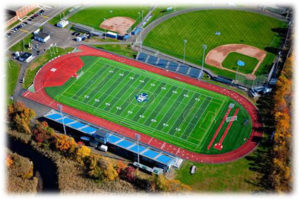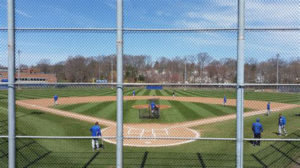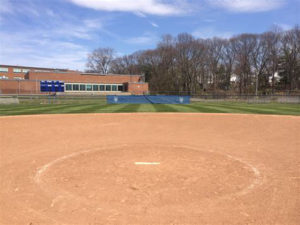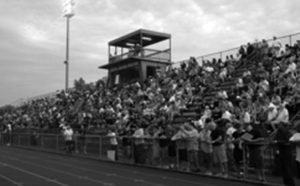
It’s hard to believe, but the city’s premiere sports venue is marking its 30th season of operation with the beginning of fall sports in a couple of weeks. The Frank Fitzgerald Athletic Complex, which comprises Ken Strong Stadium, Biondi Softball Field, Piurek Baseball Field and the Elliott Marnell Track, was opened for business with the fall season of 1989. If memory serves, the opening event was a high school football jamboree on a Friday night.
Since it opened, the Fitzgerald Complex has become the go-to site for many local and regional events in much the way the Edward L. Bennett Rink before it (opened in 1969-70 along with the pool) became a venue for state and regional contests. That reason, primarily, is the operational expertise of the complex and rink. Chris Everone is now the manager of both the complex and the rink. When it opened in 1989 he was a 12-year-old, who helped out and loved to work on the location. When it needed a manager some years back, he was the logical choice. It was a perfect match.
 Visitors to the complex are amazed at what is there, and how well kept. Baseball players love Piurek because it is well manicured; Biondi Field has been the site of many SCC and CIAC finals games, while Ken Strong Stadium is a favorite location of the CIAC football committee when tournament time rolls around. It was not always that way.
Visitors to the complex are amazed at what is there, and how well kept. Baseball players love Piurek because it is well manicured; Biondi Field has been the site of many SCC and CIAC finals games, while Ken Strong Stadium is a favorite location of the CIAC football committee when tournament time rolls around. It was not always that way.
The development of the Fitzgerald Complex happened over a long period of time. The idea to upgrade Ken Strong Stadium was the genesis of the entire complex. Ken Strong was opened in the fall of 1967 for the Hamden-West Haven game. It was marvel of construction because the swampy area on which the entire WHHS campus is located made it necessary to do a lot of prep work.
 The field was originally grass and had problems from the start. As the field settled in the 20 years since it opened, it was getting harder and harder to keep natural turf in good condition. Rain, high water tables and a lot of use made it hard to keep grass for more than a year. With the advent of artificial turf, it was thought it would be a good upgrade, and more than high school events could be scheduled there.
The field was originally grass and had problems from the start. As the field settled in the 20 years since it opened, it was getting harder and harder to keep natural turf in good condition. Rain, high water tables and a lot of use made it hard to keep grass for more than a year. With the advent of artificial turf, it was thought it would be a good upgrade, and more than high school events could be scheduled there.
Piurek Field was originally called “Frank Fitzgerald Field.” Fitzgerald is considered the godfather of the WHHS athletic program, serving as the football, basketball and baseball coach from the 1920s until the 1940s, starting when the high school was a wing of the Union School building on Union Avenue and Center Street (now a senior housing complex). Initial attempts to play games on Fitzgerald Field were unsuccessful because the field was too low, and water seeped up from the ground, never drying.

A steering committee under the direction of then-Athletic Director Tom Hunt was formed. It helped put together the plan for Ken Strong. It was decided to name the entire complex after Fitzgerald, while honoring longtime AD and baseball coach John “Whitey” Piurek with a renamed baseball field. But when the complex was dedicated, the field remained pretty much the same as it was.
Ken Strong, a Hall of Fame player with the NY Football Giants, was the natural name for the football field and was on hand for the dedication in 1967. The idea to name the track after Elliott Marnell was determined because Marnell did much to keep the track program alive.
 Over the years, the final components were put into place. Through the good offices of Beth Sabo, money was procured to build up the baseball field and put in the showplace that is now the envy of many towns in the area.
Over the years, the final components were put into place. Through the good offices of Beth Sabo, money was procured to build up the baseball field and put in the showplace that is now the envy of many towns in the area.
Hunt wanted to put in a softball field, but was not sure it would fit snugly into the place it now occupies. This writer had many discussions with him on this matter, particularly when some disaffected residents threatened a lawsuit if a venue wasn’t procured. It haunted Hunt through his life that people tried to sue to have a field put in when he did more to build up the women’s programs at WHHS. His only reservation about the field was whether it could be built where it is.
The Fitzgerald Complex was a work in progress. The last 15 years have seen the completion of that project, and the fine venue it is for high school sports.
Some may complain the city spent too much money on athletics; but the complex has been not only a great location for local athletes, but a great showcase for the city. The thousands of people who come here each year marvel at the coziness of the fields, the great views, and the use each of the fields get. Fitzgerald served as a prototype for many upgrades in the region and state.
Finally, to those who think about money and sports, the complex is a fine example of tax money used to benefit a large swath of the community – and one that can be seen. Very few investments are so readily visible for their use.
As the complex begins its 30th season, we think of the thousands of high school and youth players who have stepped onto its fields. In a city that has many problems, the Fitzgerald Complex is a positive force in the community.